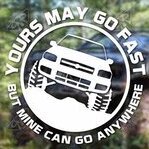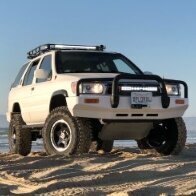Leaderboard
Popular Content
Showing content with the highest reputation on 03/23/2023 in all areas
-
97 Quey with Bosch Oscar fog’s recessed into the grill. Easy add on. The grill is actually still one piece. Sent from my iPhone using Tapatalk1 point
-
1 point
-
Yeah my kids love them, they love having their own space camping. We originally had a soft floor camper trailer, that the kids shared with us, they eventually wanted and got swags, and then my wife and I were asking why are we still spending an hour to set up/pack up such a large camper??? So that was when we started looking at getting ourselves something a little "glamping" and we worked our way up to our hybrid offroad caravan, hence the reason for Hoss. And before you yankees ask, this is a soft floor camper:1 point
-
Just so you can see what a swag is ? This is our regular camp set up. the boss and I in the camper trailer, and the kids in their swags. The swags are basically heavy duty canvas dome tents with built in mattress and can be rolled up with all bedding and pillows ready to go1 point
-
I am very conscious of any weight put on the rack, the rack is predominately there as a way to carry the kids swags lucky to be 20-30kg max, the green one (in the picture with the van hooked up) is a Kings Big Daddy and weighs around 16kg and the other swag is a single which is lighter again. There is no lateral movement on the mounts, they are seated firmly on the mount points in the channel, the box section is 20mm x 50mm (3/4"x2" for you yanks ) and it fits and seats nicely on the mount points. These box section mounts have the same if not more contact on the channel as factory mounts, and they are bolted using the factory hardware, I have evry faith in them. The angle bracket resting in the channel is a very tight fit and I have not had any vibration evident as yet. As for wearing through the paint, I am not too concerned as she is a bush basher, and I may be Raptor lining the whole rig yet, and from what experience I have with the product it will withstand and protect the panel/paint from that sort of wear. Plus the way the 6 points are mounted to the cage give added rigidity. I will keep an eye on it, either way. Thanks for the questions and feed back1 point
-
So awesome you guys. One bolt on supercharger kit with a side of solid front axle plz1 point
-
I half deleted mine after it sent charcoal through the evap lines all the way to the intake, plugged up the lines solid. After blowing out the charcoal out of the lines and tapping on the canister until it was empty, I put it all back together. The system does a self test periodically to check for leaks by letting the intake pull a vacuum on the system, if there is a leak like a bad gas cap seal, or something else it will cause a SES light and a code. I'm not sure if it does this test every run cycle or every number of them, but before I discovered the charcoal problem, clearing the code would have it stay gone for a while, a few days to up to a week. This made me think several times the problem was gone, only to have the code come back. Perhaps only certain conditions like high engine RPM allow the self test to happen, so with easy driving you could dodge a code maybe? I can't recall all the components sending signals to the ECU in the system, but I think there are at least 3 valves and a vacuum sensor to deal with. The signals are not constant, such that the ECU only looks for the vacuum signal when the self test is commanded. There is also a vacuum cut valve that shuts the system off from the intake during engine start so it dose not provide a vacuum leak. I also believe it monitors the state of the valves so if one sticks it throws a code. Much more than I wanted to try to spoof, so I reinstalled everything and the whole system works like it should, only with no charcoal to adsorb fuel vapors. No codes since.1 point
-
Sometimes there's no mod available that will prevent you from getting stuck in mud. Before driving over difficult terrain, especially mud (which is usually a lot deeper than you expect), You need to decide the risk of getting stuck and have an action plan for getting yourself unstuck if you go for it and don't make it. That being said, one of the first things any 'wheeler should get (even before tires and a lift!) is a 30,000 lb. tow strap and a pair of D-ring shackles. You can get D-ring shackles at most hardware stores, near where they sell chain, or you can buy them online as well. 30,000 lb. tow straps D-ring shackles Put one loop of the tow strap through the D-ring, and put the D-ring on one of the tow hooks on the front of the Pathfinder. If you have a trailer hitch, insert the loop of the tow strap through the receiver, then secure it in place with the receiver pin. Alternatively, you can use one of these. If mud is your favorite type of terrain, you will probably not want to get AT tires, but MT tires, such as Bridgestone Dueler MT, BFG MT, Interco TRXUS or something that has a more agressive tread pattern. AT tires don't do so well in mud. You'll also probably want to get yourself a good pressure washer so you can clean off the underbelly after you're through. Another thing that you'll find will help your truck in most other types of terrain is reducing the air pressure in the tires to 18psi. Of course, if you do this you will need some way of reinflating the tires for extended highway driving. A cheap cigarette-lighter-powered air compressor is an affordable introductory solution. Anyway, getting back to your question about manual hubs. Your truck comes with full-time hubs or "drive flanges" that set the entire front drivetrain in motion whenever the truck is moving, no matter what mode the transfer case is in. This is what allows you to "shift on the fly" into 4WD at speeds up to 50mph. (Mechanically, it doesn't matter what speed you're going, but you probably shouldn't be going over 50mph if you're feeling the need to shift into 4WD anyway.) Although the front drivetrain always turns, it basically "freewheels" unless 4WD is engaged. Naturally, a constantly-spinning, but unpowered drivetrain will negatively influence fuel economy, too. Aside from potential fuel economy losses, the problem with drive flanges is that they contribute to premature wear of the CV boot, especially when a lift is installed, since the CV joint angles increase. This is why many people install manual hubs as part of a lift. With manual hubs, you basically have two modes: locked and unlocked. When the hubs are locked, they behave just like drive flanges. When unlocked, the wheels are mechanically disengaged from the axleshafts. In other words, wheel rotation can now occur independent of drivetrain rotation. Another advantage of manual hubs is drivetrain failure. I recently snapped a front CV axle while off-roading in Utah. I was able to unlock the hubs and continue driving without causing further damage. In fact, I drove over 1200 miles back home with a broken CV axle. This could not have been done without manual hubs. Installing hubs with the lift is definitely optional, though. I don't think I installed manual hubs in my truck until over a year after it was lifted, and even then I did so only in hopes of increasing fuel economy. The other advantages became apparent afterwards, and besides, I didn't get as much fuel economy benefit as I had hoped anyway.1 point
-
I say go for it, but be aware of a few things that will arise from lifting it. These are in regards to the 2" (advertised) lift (I got 3"F and 3.5"R): Firstly, your front struts WILL top out going over bumps. This WILL NOT cause any significant problems, it is more of an annoyance than anything. But it will scare the living crap out of you the first time it happens, and you'll turn around and go right back to the shop and be like WTF! :confused: I've had my lift on for 50,000 miles, and the struts are just now starting to feel like they're wearing out. I'll likely have to replace them in about 10,000 miles...KYB's estimated useful life for them is ~60,000 miles anyways. I think that I've gotten a great amount of life out of them considering how and where I drive my truck. Secondly, your CV axles will be at a more extreme angle, and this will expedite the wear on the boots. To alleviate this, I HIGHLY suggest getting the Warn Manual locking hubs to replace your full time drive flanges. With the warn hubs unlocked, and the t-case in 2wd, you have the entire front driveline disengaged, and nothing is turning. This in turn creates less wear on the front end driveline parts, and will give you a slight increase in fuel economy. (I saw about a 1.5-2mpg increase). I did not install the manual hubs immediately, and regret not doing so, because I had to replace both CV axles at the same time, to the tune of $200. Thirdly, since the 2" AC coils are not any longer than the factory coils, but are simply a higher spring rate, the ride of your truck will change completely. I love the way my truck rides now. Before I lifted it, it felt like a station wagon, now it feels like a truck should. It will ride stiffer, and the suspension will be a lot firmer. Stock, you can fit 31x10.50" tires on your factory rims. With the lift, I had no problems fitting 32x11.50x15" tires on 15x8" rims with 3.75" Backspacing. In order to fit 32s, you MUST get new wheels with a backspacing of no more than 4", otherwise, the tires will not clear the strut. Finally, nothing can be better than the looks you get driving a newer Lifted Pathfinder with big mud-tires...I LOVE IT! I say DOO EET!!!1 point





